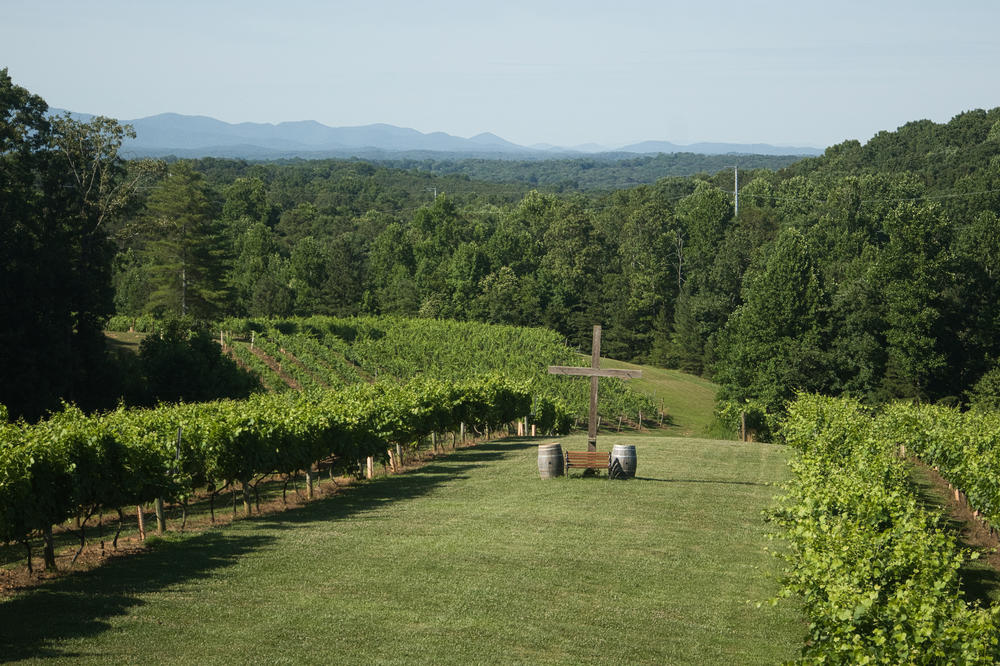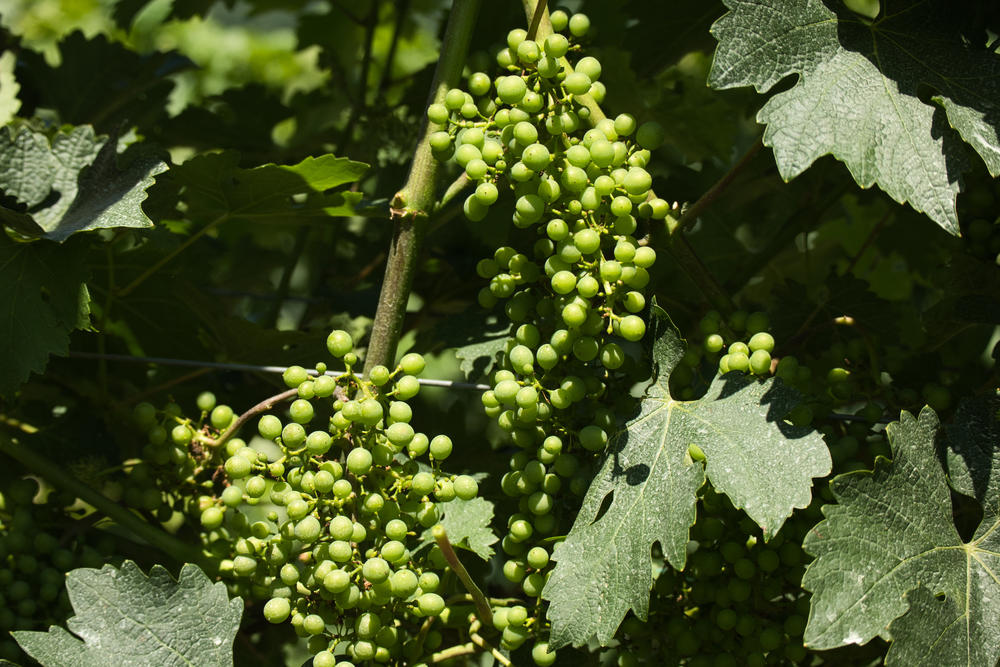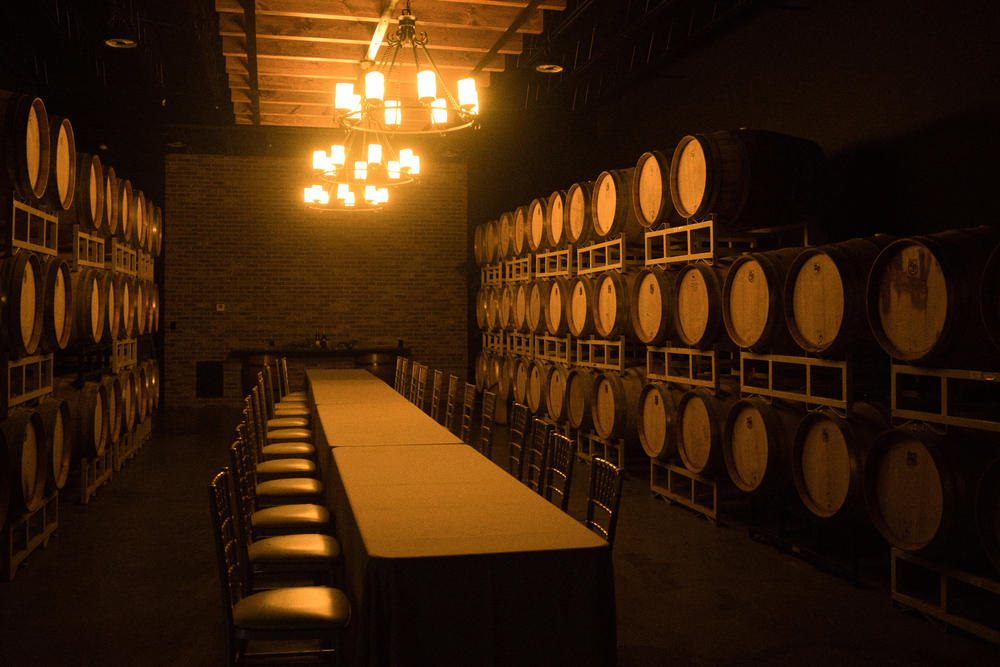
Caption
Grapevines at Engelheim Vineyards in Ellijay, Georgia on June 20, 2022.
Credit: Alex Guevara/Fresh Take Georgia
Visitors to Qualusi Vineyards in Acworth may be surprised when their GPS leads them down a cul-de-sac of a residential subdivision in suburban Paulding County.
But once they turn into the vineyard’s gravel road, they will see rows of grapevines along the side of the gravel drive that leads up to the tasting room and outdoor seating.
There, patrons listen to live music, eat from food trucks and sip one of Qualusi’s 11 wines. Chardonnay, pinot noir and Norton grapes go into the red wines like Qualusi’s smooth, savory Malbec with notes of red plum and blackberry or Merlot with a round, balanced flavor and smoky finish, as the vineyard describes them.
Owner Emilee Gilbert planted the vines in 2017 to add a new crop to the family-owned flower farm. Hers is one of about 60 wineries that make up a growing industry in Georgia — one of the few industries that not only weathered the pandemic so far but many say has thrived as people seek novel outdoor activities, Taree Darby, Executive Director of the Georgia Wine Producers, said.
“It was a place that people felt safe,” Gilbert said. “We promoted a tailgate style atmosphere, and that’s stuck with us today. People bring their own picnic blankets and lawn chairs and we have places to set up with a glass of wine on the grounds.”
According to the Georgia Department of Revenue, wineries contributed $48.7 million in taxes and fees to public coffers in 2021. That’s up from $40.1 million in 2017 and up from $42.7 million from 2019, right before the pandemic started.
That means Georgia wine producers and sellers are selling more wine and more businesses have applied for licenses to produce and serve wine.
Georgia Wine Producers, the industry’s trade organization, estimates that the state’s wine industry supports more than 35,000 jobs, many of them in rural areas. Not all wineries have their own vineyard on site, but many do and use the setting as a draw.
The grapes grown on-site, like those that surround the tasting room with rows of vines on wire trellises at Qualusi Vineyards, provide a visually attractive place for patrons to drink wine, although not all wineries exclusively use on-site grapes. Some wineries bring in grapes or juice from other farms both in and out of state because grapes take several growing seasons to become viable for winemaking.

Grapevines at Engelheim Vineyards in Ellijay, Georgia on June 20, 2022.
“The opportunity for agritourism and the opportunity for events is critical,” said Philip Brannen, a plant pathologist at the University of Georgia who has worked with Georgia wineries for 22 years. “When you have that, you bring in a lot of people, and that opens up people staying in hotels, going to restaurants, all the other things that little communities might not always have.”
North Georgia has gained a reputation as a wine-tasting destination — Dahlonega Plateau is the only American Viticultural Area in the state, receiving the title in 2018. However, Darby said she hopes to see more wineries across the state, rather than just in the northern areas.
“The wineries in South Georgia are few and far between,” Darby said. “If we could get more wineries open down there, we could have more of a North Georgia industry where you can have a day trip and visit two, three, five wineries in a day.”
Georgia’s climate can post a challenge, which contributes to the lack of wineries in South Georgia. While local varietals like muscadines are accustomed to Georgia, European grapes face issues related to the heat and rainfall in the state, which can make the plants vulnerable to diseases not prevalent in their native ranges.
“We get downy mildew, which, if you have a dry climate like California, you don’t see it,” said Brannen, the plant pathologist from UGA. “But we also get powdery mildew, which is a dry weather fungus. We get any disease that can occur on grapes, so that makes it difficult.”
Because of the South Georgia climate and the long growth period for grape vines to be viable for winemaking, more wineries have opened in the mountainous areas in the northern part of Georgia.
Connie Baptiste, a catering chef from Locust Grove, is in the beginning stages of starting a vineyard and winery in Sylvania in Middle Georgia close to where she grew up. She is working with an expert to determine the best grapes to plant on her 44 acres of land.
Baptiste said she wants to bring jobs and tourism to the area and show young people that farming can be a good career.
“There are very few wineries below Macon, so for me to come into this space to learn and be willing to do it, I think I have the opportunity to change the trajectory and the look of what a Georgia wine producer looks like,” she said.
Despite its growth and the resilience of winemakers who produce in South Georgia, the wine industry still faces challenges, especially for wineries located within city limits.

Cabernet sauvignon grapes is one of the Bordeaux varietals grown at Fainting Goat Vineyards in Jasper, Georgia, June 20, 2022.
Painted Horse is the only farm winery in the city of Milton in north Fulton County. In addition to growing grapes that will soon be used for its nine wines, owner Pamela Borgel raises horses, cows and bees. The farm was started in 1994 and the tasting room opened in 2018.
Last year, the city placed a moratorium on new wineries and limited the hours Painted Horse can open its tasting room. City Council member Paul Moore said the moratorium was passed because officials are in the process of revamping local codes and don’t want new wineries to open under rules that may change.
But Borgel is unhappy with the city’s approach. Under the old codes she was allowed to host weddings or corporate events at Painted Horse, but the city’s revamped codes mean that now any event must relate to agricultural activity.
“We make our living at our farm, and without the commerce and without the ability to sell and be open the hours we need to be open and do the events that we need to do, we won’t be able to make it,” Borgel said. “The city of Milton has not been supportive in helping the working farm.”
Despite the challenges winemakers face throughout the state, Georgia Wine Producers expects the wine industry to continue growing, Darby said.
The work to open one winery can open the door for more to follow in the future. Qualusi Vineyards was the first winery in Paulding County, but the groundwork laid by Gilbert in 2017 was already in place when Three Strands Vineyard and Winery opened nearby in 2021.

The wine barrel room at Engelheim Vineyards in Ellijay, Georgia on June 20, 2022.
“It’s nice to see that work wasn’t just for us, and other wineries will be able to come behind us in the county,” Gilbert said.
Wineries benefit from close proximity to each other — people like to make a day trip or weekend trip to visit multiple wineries, so as more open, more people will come to that area for the tasting rooms, Gilbert said.
Because every winery offers a different experience, having more provides a chance to build the winemaking community rather than induce fierce competition.
“You can’t really compare yourself to anyone else,” Gilbert said. “It’s not like you’re opening another Arby’s or something, where you can see what works. It’s unique, and that’s why no one is really competition. Everyone is different.”